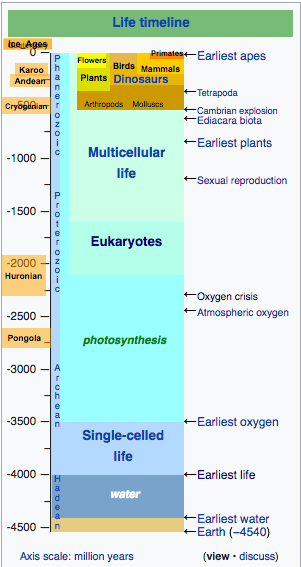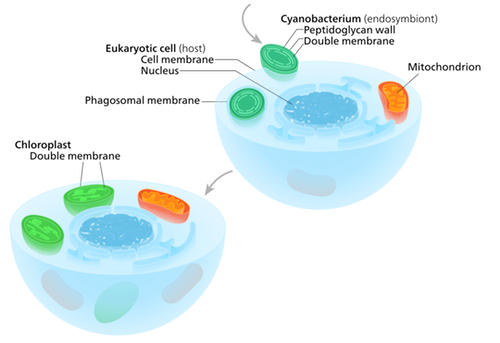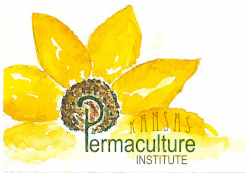Author's note: It's generally accepted that the reason aerobic microbes weren't around to prevent the Great Oxygenation Event is because they hadn't evolved yet. It's very convenient that they evolved just in the nick of time to save all life on earth from going extinct. But I got to thinking, what if they had evolved earlier, and they just weren't invited to the party? Then the story starts to seem very familiar...

Once upon a time, about three and a half billion years ago, there was no life at the surface of the earth. The reason was that there was no ozone layer to shield the earth from the sun's ultraviolet light. Every day the sun shone down with all its force and burned up any microbes that had ventured to the surface overnight. So the first living things lived only at the bottom of the ocean, where volcanic vents spewed out all kinds of wonderful chemicals for microbes to eat. They didn't have names at the time, but let's give them names for this story based on their metabolisms — that is to say, what they ate for energy.
There was Dasher, who liked to eat carbon dioxide and hydrogen and turn them into methane and water, plus a little burst of energy. The methane bubbled into the atmosphere and started the first greenhouse effect, warming the earth so that other creatures could live. Dancer and Prancer got their little burst of energy from turning sulfate into hydrogen sulfide. Those three went everywhere together, and they smelled of rotten eggs on account of all the sulfur they ate. Then there was Vixen, who could turn nitrogen and hydrogen into ammonium, plus a little burst of energy. There were lots of others, too, but we don't need to name them all.
There was a microbe named Rudolph, and it's true he was red in color, but contrary to what you might think, none of the other microbes cared about that because it was dark down there at the bottom of the ocean. No, the reason the other microbes didn't like Rudolph was because whenever they had parties, he would bring his favorite food, and even just the smell of it made everyone else sick. Nobody wanted to have the awkward conversation and tell him to stop bringing his favorite food to parties, so they took the easy way out and just stopped inviting him to join in their microbe games. But this isn't Rudolph's story, not yet.
This is Donner and Blitzen's story, because at this time, three and a half billion years ago, Donner discovered a way to capture sunlight. It wasn't chlorophyll yet — Blitzen discovered that later — but thanks to the hydrogen sulfide Dancer and Prancer had produced, Donner could venture up toward the surface of the water, catch some sunlight, and use its energy to make sugar. You'll notice there was no burst of energy. The energy went into making the sugar. There was nothing so new about this; all the microbes made sugar to store energy until they needed it later. But there was so much sunlight up there at the surface, Donner had enough sugar to give some to all of his friends, so they didn't have to bring their own food to the party! If you've ever been to a party where there wasn't enough food, you can understand why the first party with plenty of sugar for everyone was the best party ever! It was so amazing, it lasted for a billion years!
That's not an exaggeration, the party actually lasted a billion years. Donner and the other microbes reproduced themselves like mad and covered the whole surface of the ocean, producing sugar just as fast as they could and eating it just as fast. Entirely new microbes like Comet and Cupid evolved just to eat the excess sugar and turn it into new chemicals like alcohol, taking the party to a whole new level. Then, fashionably late by about 700 million years, Blitzen arrived on the scene and things really got crazy.
See, while Donner produced sulfur along with his sugar, Blitzen released oxygen. Oxygen was toxic to everyone else at the party: Dasher, Vixen, Donner, Comet, the whole crew. Only Blitzen herself was resistant to the stuff. But it wasn't a problem at first, because the ocean had lots of iron in it, and the iron absorbed the oxygen just as fast as Blitzen could crank it out. The iron oxide (usually called rust) sank to the bottom of the ocean and colored the rocks red. If you've ever seen red rocks or red clay dirt, that's the litter left over from the longest party in history!
Eventually the iron in the ocean started to run out, but it wasn't a problem because the oxygen in the atmosphere got zapped by the high-energy sunlight and turned into ozone. The layer of ozone then blocked the worst of the sun's ultraviolet light, making it safe to live right at the surface of the ocean for the first time. Blitzen was the most popular microbe ever: not only did she make even more sugar for everybody, she also made it safe for everyone to come out into the sunshine!
Blitzen was so popular and successful she started to crowd out Donner. More and more of the sugar was getting made with oxygen as a byproduct, and more and more oxygen was pouring into the atmosphere. But the upper atmosphere is a big place, and it can hold a lot of ozone.
Then one day, two and a half billion years ago — maybe it was a foggy Christmas Eve; it's hard to say — the ozone layer was full. With no more high-energy sunlight getting through to convert oxygen to ozone, oxygen started to accumulate in the atmosphere for the first time. The microbes who were used to living on the surface had to sink a little deeper to stay safe. But Blitzen and her trillions of trillions of offspring were still bubbling out oxygen, and it started to build up in the water as well. I'd like to say that the microbes just sank deeper into the ocean to get away from the toxic gas, but the truth is that trillions upon trillions of them were burning up on the inside and dying! Meanwhile, the oxygen had destroyed most of the methane in the atmosphere. Without its protective blanket of methane, the earth went into an ice age so severe that all the oceans froze over with ice and the whole planet became a snowball for over 300 million years! The party was over in a huge way, and it was the first mass extinction in history.
Meanwhile, back down at the bottom of the ocean, Rudolph was sulking. Nobody had invited him to the party. Can you imagine? A billion year long party, and nobody invited him, and all because nobody else liked the oxygen he liked to eat. Why, here was some oxygen now! And some sugar, too? Don't mind if I do, thought Rudolph. He combined the sugar with the oxygen, and bam! What a burst of energy that was! Rudolph floated upward and found more oxygen and sugar. Bam! What a kick! Fueled by the power of this new reaction, he reproduced a few trillion times and found a crack in the ice at the surface of the ocean, where his red color shone in the sunlight for the first time. He and his aerobic offspring gradually made the water safe for all the anaerobic microbes, and in the process they released so much carbon dioxide they brought back the greenhouse effect and melted the snowball earth.

Then how the microbes loved him! They told him he'd go down in history and all that. A few of them were so enthusiastic that they gave him and his offspring a big hug and popped Rudolph inside their bodies, where the aerobic microbes became mitochondria. To this day, every human cell, every animal cell, every plant and fungus cell has mitochondria inside, and they are still red in color, and they still have microbe DNA, not human or animal or plant DNA. Your mitochondria are not you — they're Rudolph!
Some of these new eukaryotes also found it in their nuclei to forgive Blitzen for almost destroying the world, and they gave her a big hug too, and she and her offspring became chloroplasts. The little green dots inside plant cells that allow green plants to make sugar from sunlight do not have plant DNA, they have microbe DNA that goes all the way back to Blitzen.
But Blitzen is still around; we call her offspring cyanobacteria, and they're the most diverse and successful creatures on Earth, and to this day they still make about 25% of all the oxygen we breathe. Rudolph's offspring are still cleaning up messes today; they're the aerobic microbes that turn our garden waste into compost and digest our sewage in treatment plants. The anaerobic microbes Dasher, Dancer and Prancer are still around: whenever your gas smells like rotten eggs, you know they're having a party in your guts and helping you digest your food. And if you see a stagnant pond that's turned purple, you know Donner is there cleaning up after those three!
Comet and Cupid are very important to our digestion, food preservation, and keeping the other microbes in line, and Vixen still turns nitrogen from the air into ammonium, which helps plants grow. But these three still can't handle oxygen, so in the soil, they and the other anaerobic microbes can only and do their crucial work where the fungi (which hold crumbs of soil together) are undisturbed.
How plants and fungi and bacteria came to live on land and work together to make soil is another story.
Notes for the nitpicky
- Throughout this story I use the word "microbe" to cover bacteria and archaea, because the distinction between the two is not important to the story.
- Molecular oxygen is not something that comes out of volcanic vents, so what I'm calling Rudolph's favorite food would have been some other microbes' waste, which could explain why the smell of it made them sick!
- The sharing of sugar among the microbes was not as peaceful and amicable as I've made out, but it also wasn't violent: the first predators hadn't evolved yet! Back then, microbes were killed primarily by viruses or by natural causes, and other microbes then ate their remains. But that shouldn't be too surprising, since after all it was a Donner party.
- Similarly, the absorption of aerobic microbes (Rudolph) and cyanobacteria (Blitzen) into eukaryotes' organelles may not have been consensual. It's hard to say whose idea it was, but it's safe to say it's turned out to be among the most successful partnerships in history.
- Log in to post comments





Comments